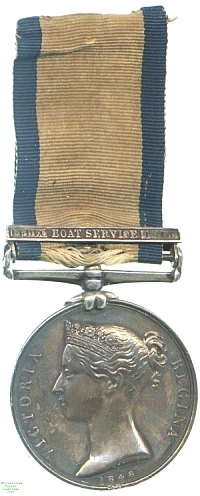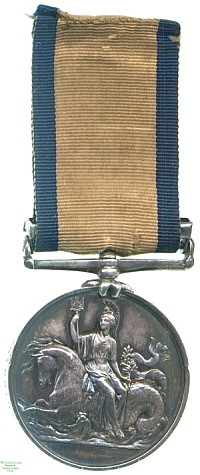
Obverse, a bust of Queen Victoria

Reverse, Britannia with a trident seated sideways on a seahorse

Obverse, a bust of Queen Victoria |

Reverse, Britannia with a trident seated sideways on a seahorse |
Just as in 1848 the extensive land campaigns of the Napoleonic Wars and the other conflicts of the pre-Victorian era were recognised by the issue of the Miltary General Service Medal, those serving in the Navy at the time were recognised with the Naval General Service Medal. As with the Army equivalent and the East India Company's related award, many of the battles for which the medal was awarded had been fought so long ago that few if any claimants survived.
In addition, bars were awarded for many actions whose significance and size were, despite the heroism displayed by those involved, relatively minor. The result was that many of the bars were issued in tiny numbers, with some combinations all but unique, and the medals command a very high price among collectors because of this rarity and individuality. This in turn, along with the manufacture in most cases of more bars than were eventually issued, has led to the `improvement' of many common awards where recipients' names are shared with those present at `rarer' battles. The medal also shares with the Military General Service and Army of India Medals the oddity that Queen Victoria, whose portrait they bear, was not the ruler under whom the battles for which it was awarded were fought.
Some of the actions for which the NGSM was awarded were fought not from ships, but from ships' boats, combats which could on occasions be no less dangerous or destructive than ship-to-ship battles. The last and largest of these encounters that the NGSM's award recognised involved more than a thousand men, and was fought off New Orleans on 14 December 1814. Before the town could be assaulted by the Royal Navy and its Marines the guardships had to be destroyed. A force of boats despatched from 16 different Navy warships were able to capture one of the enemy vessels and take it over, and with its aid destroyed the other four. The British assault was ultimately unsuccessful and led to the opening of peace negotiations, but the naval attack is still a memorable triumph for a force working from rowing boats.
This medal was awarded to Midshipman Francis Dornford: it does not record in which ship's boat he served. The Medals Roll confirms the award of the piece to him, although on it his name has been officially corrected from the initial engraving of it as `Durnford'. Lester Watson purchased the medal from the London dealers Baldwin at some point before 1928; they had it from a Glendining auction of October 1925.